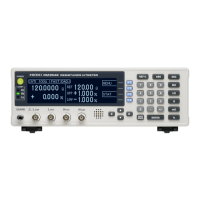9.5 Communication Methods
109
9
This instrument implements the status model defined by IEEE 488.2 with regard to the serial
poll function using the service request line.
The term “event” refers to any occurrence that generates a service request.
The Status Byte Register contains information about the event registers and the output
queue. Required items are selected from this information by masking with the Service
Request Enable Register. When any bit selected by the mask is set, bit 6 (MSS; the Master
Summary Status) of the Status Byte Register is also set, which generates an SRQ (Service
Request) message and dispatches a service request.
RS-232C does not provide a function for issuing service requests. Still, SRER setup and STB
reading are available.
Status Byte Register
bit7 bit6 bit5 bit4 bit3 bit2 bit1 bit0
unused
SRQ
ESB MAV
unused unused
ESB1 ESB0
MSS
&&&&&&
bit7 bit6 bit5 bit4 bit3 bit2 bit1 bit0
unused
0 ESB MAV
unused unused
ESB1 ESB0
Logical
Status Byte
Register (STB)
Service Request Enable
Register (SRER)
Service Request
SRQ occurrence
Output Queue data information
Standard Event Register Description
Each of these bits corresponds to a specific event register
Overview of Service Request Occurrence
SRQ (Service Request) is a GP-IB function only. However, STB (Status Byte Register) infor-
mation can be acquired with RS-232C using the
STB? command.

